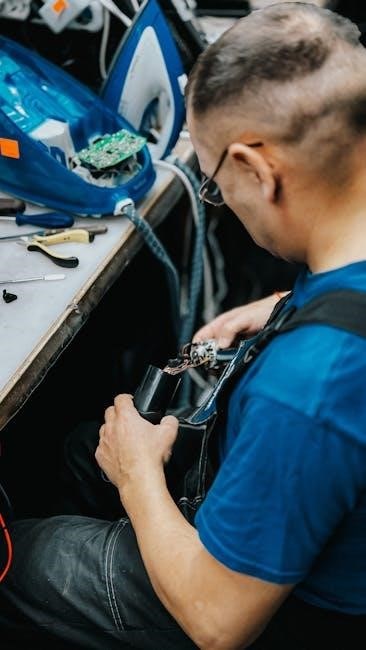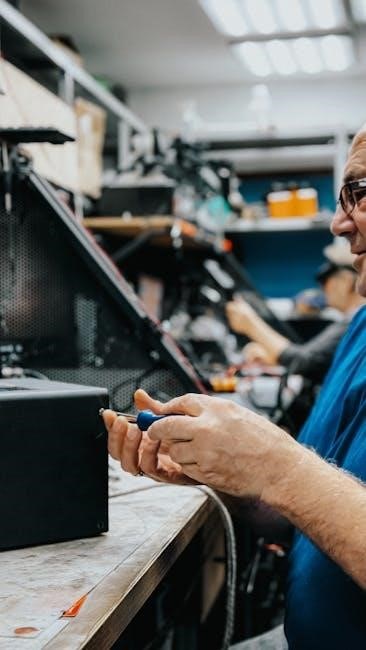The 4L60E is a widely used electronic automatic transmission known for its durability and versatility in various GM vehicles. This guide provides essential steps‚ torque specifications‚ and parts lists for a successful rebuild‚ ensuring optimal performance and longevity. Perfect for DIY enthusiasts and professionals alike‚ it covers disassembly‚ inspection‚ and reassembly processes in detail.
Overview of the 4L60E Transmission
The 4L60E is a highly reliable electronic automatic transmission developed by General Motors‚ widely used in trucks‚ SUVs‚ and performance vehicles. As an evolution of the THM700R4‚ it features advanced electronic controls‚ four speeds‚ and an overdrive gear. Known for its durability and versatility‚ the 4L60E is popular among enthusiasts and professionals alike. However‚ like any transmission‚ it can experience wear over time‚ requiring a rebuild to restore performance. This manual provides a comprehensive guide to rebuilding the 4L60E‚ including detailed procedures‚ torque specifications‚ and parts lists‚ ensuring a successful overhaul and optimal transmission function.
Importance of a Rebuild Manual
A rebuild manual is crucial for successfully overhauling the 4L60E transmission. It provides step-by-step instructions‚ torque specifications‚ and detailed diagrams‚ ensuring each component is correctly installed and adjusted. Without a manual‚ DIY enthusiasts and technicians risk damaging parts or misaligning critical systems‚ leading to costly repairs. The manual also highlights essential safety precautions‚ preventing potential hazards during disassembly and reassembly. By following the guide‚ users can restore their transmission to factory specifications‚ enhancing performance and longevity. This resource is indispensable for anyone aiming to rebuild the 4L60E efficiently and effectively‚ avoiding common pitfalls and ensuring a professional-grade result.

Preparation and Tools
Essential tools include a torque wrench‚ socket set‚ and seal installer. Gather transmission fluid‚ filters‚ and gaskets. Proper preparation ensures a smooth rebuild process and prevents delays.
Essential Tools for the Rebuild
The 4L60E rebuild requires specific tools for accuracy and safety. A torque wrench‚ socket set‚ and seal installer are indispensable. Specialized tools like a bearing puller and transmission pan gasket scraper are also necessary. Ensure you have a clean workspace and organize parts as you disassemble. Additional tools include a dial indicator for measuring end play and a hydraulic press for bearing installation. Refer to the manual for torque specifications and proper tool usage. Having the right tools prevents damage and ensures a successful rebuild. Many of these tools can be sourced from automotive stores or online retailers specializing in transmission repair.
Fluid and Filter Preparation
Proper fluid and filter preparation is crucial for a successful 4L60E rebuild. Use Dexron III or VI transmission fluid‚ with a capacity of approximately 4-5 quarts. Replace the transmission filter during the rebuild to ensure cleanliness and optimal flow. Inspect the pan gasket for damage and replace if necessary. Always use a new filter gasket to prevent leaks. Ensure the fluid level is correct after reassembly‚ as overfilling can damage the transmission. Refer to the manual for specific fluid recommendations and capacity details. Proper fluid preparation ensures smooth operation and extends the transmission’s lifespan. Always consult the manual for precise specifications.
Safety Guidelines and Precautions
Always wear protective gear‚ including gloves and safety glasses‚ when working on the 4L60E transmission. Ensure the vehicle is securely lifted on jack stands and the transmission is properly supported. Disconnect the battery to prevent accidental start-ups. Use approved tools to avoid damaging components. Be cautious of sharp edges and moving parts. Keep the workspace clean and well-ventilated‚ especially when handling transmission fluid and cleaning solvents. Follow proper procedures for draining fluid to avoid spills. Never smoke or use open flames near flammable materials. Refer to the manual for specific safety warnings and precautions to ensure a safe and successful rebuild process.

Disassembly Process
The disassembly process involves removing the torque converter‚ disconnecting the valve body‚ and extracting the oil pump. Use specialized tools and follow the manual’s step-by-step guide for a smooth rebuild.
Removing the Torque Converter

Begin by marking the torque converter’s position on the transmission for proper realignment later. Drain the transmission fluid to prevent spills during removal. Use a wrench to loosen the torque converter bolts while the transmission is secure. Completely remove the bolts and carefully pull the converter straight out. Be cautious‚ as the converter is heavy and may still contain residual fluid. Inspect the converter for damage or wear‚ such as cracked welds or excessive play‚ and replace it if necessary. Proper removal ensures a smooth rebuild process and prevents potential damage to other components.
Disconnecting the Valve Body
Disconnecting the valve body is a critical step in the 4L60E rebuild process. Start by removing the electrical connectors from the solenoids and sensors to prevent damage. Use a wrench to disconnect the transmission lines from the valve body‚ ensuring all fluid is drained. Next‚ remove the mounting bolts that secure the valve body to the transmission case. Gently pull the valve body away‚ taking care not to damage the mating surfaces or internal components. Once removed‚ inspect the valve body for wear or debris and clean it thoroughly before reassembly. Proper disconnection ensures a smooth and accurate rebuild process.
Extracting the Oil Pump
Extracting the oil pump is a delicate process in the 4L60E rebuild. Start by removing the bolts that secure the pump to the transmission case. Use a socket wrench to ensure proper torque removal. Gently pull the pump straight out‚ taking care not to damage the mating surface or internal components. Inspect the pump for wear or debris and clean it thoroughly. If damaged‚ replace it with a new or rebuilt unit. Apply a thin layer of transmission fluid to the new pump’s sealing surface before reinstallation. Tighten the bolts to the specified torque to ensure proper sealing and function.

Inspection and Cleaning
Inspecting components for wear and damage is crucial. Cleaning involves using solvents and compressed air to remove contaminants‚ ensuring proper function after reassembly.
Inspecting Transmission Components
Inspecting transmission components is a critical step in the rebuild process. Start by examining the gears‚ bearings‚ and clutch packs for signs of wear‚ scoring‚ or damage. Use a micrometer to measure gear teeth and bearing surfaces‚ ensuring they meet factory specifications. Check the torque converter for cracks or imbalance and inspect the valve body for worn or damaged solenoids. Look for metal shavings in the transmission pan‚ which indicate internal damage. Clean and visually inspect all parts under bright light to identify any hidden issues. This thorough inspection ensures only viable components are reused‚ guaranteeing a reliable rebuild.
Cleaning Procedures for Parts
Cleaning transmission parts is essential for a successful rebuild. Start by soaking components in a solvent bath to remove grease and debris. Use a parts washer or ultrasonic cleaner for intricate pieces like solenoids and valve body components. For stubborn residue‚ employ media blasting with fine abrasive materials. Rinse all parts with compressed air to ensure no contaminants remain. Avoid using abrasive materials that could scratch surfaces. Dry components thoroughly before reassembly to prevent corrosion. Cleanliness ensures proper function and longevity of the transmission‚ making it a critical step in the rebuild process.

Parts Replacement and Upgrades
Replacing worn parts and upgrading components enhances performance and durability. This step ensures optimal transmission function and longevity‚ crucial for a successful rebuild.
Replacing Worn or Damaged Parts
Replacing worn or damaged parts is critical for ensuring proper transmission function. Components like seals‚ gaskets‚ and clutch packs often require replacement. Inspect parts thoroughly for wear or damage. Use genuine or high-quality aftermarket parts to maintain reliability. Torque converters and solenoids may also need replacement if faulty. Always refer to the manual for specific torque specifications and installation procedures. Proper replacement ensures smooth operation and prevents future issues. This step is vital for a successful rebuild and long-term performance of the 4L60E transmission.
Upgrading Components for Performance
Upgrading components during a 4L60E rebuild can significantly enhance performance. Consider installing high-performance clutch packs for improved durability and heat resistance. Modified valve body components can optimize shifting characteristics‚ especially for racing or towing applications. Upgraded torque converters with higher stall speeds can improve acceleration. Billet input and output shafts are recommended for added strength. Aftermarket solenoids and electronic controls can refine transmission responsiveness. These upgrades ensure the transmission handles increased power and stress effectively. Always consult the manual for compatibility and installation guidelines to achieve optimal results.

Reassembly Process
Reassembly involves carefully reinstalling components like the oil pump‚ valve body‚ and torque converter. Follow torque specifications and alignment guidelines to ensure proper function and longevity.
Reinstalling the Oil Pump
Reinstalling the oil pump requires precision to ensure proper transmission function. Apply a thin layer of gasket sealant to the pump’s mating surface. Align the pump with the case‚ ensuring it seats evenly. Tighten the mounting bolts in a star pattern to the specified torque. Connect the electrical connector and fluid lines securely. Prime the pump by turning the input shaft manually to circulate fluid. Verify all connections for leaks and ensure the pump operates smoothly. Proper installation is critical for maintaining hydraulic pressure and preventing internal damage during reassembly.
Reconnecting the Valve Body
Reconnecting the valve body is a critical step in the 4L60E rebuild process. Begin by applying a thin layer of gasket sealant to the valve body’s mating surface. Align the valve body with the transmission case‚ ensuring proper orientation. Secure it using the specified bolts‚ tightening them in a star pattern to the recommended torque. Reconnect the electrical connector and fluid lines‚ ensuring they are firmly attached. Double-check all connections for leaks and proper alignment. This step is essential for restoring hydraulic control and ensuring smooth transmission operation. Proper reconnection prevents fluid pressure issues and maintains optimal performance.
Reattaching the Torque Converter
Reattaching the torque converter is a precise process in the 4L60E rebuild. Align the converter’s splines with the transmission’s input shaft‚ ensuring proper engagement. Secure the converter using the factory-specified bolts‚ tightening them in a star pattern to avoid uneven pressure. Verify the converter is fully seated against the transmission case to prevent damage. Check the balance of the converter to ensure smooth operation. Proper alignment and securement are critical to avoid vibration and ensure efficient power transfer from the engine to the transmission. This step is vital for maintaining optimal performance and preventing premature wear on internal components.

Testing and Validation
Testing and validation ensure the rebuilt 4L60E operates correctly. Perform initial start-up checks‚ monitor internal temperature‚ and test under load conditions to verify performance and reliability.
Initial Start-Up and Checks
After reassembly‚ perform initial start-up checks to ensure proper function. Check for leaks‚ monitor transmission temperature‚ and verify electrical connections. Use a scan tool to review internal sensors and solenoid operation. Ensure the fluid level is correct and the transmission is in “Neutral” before starting the engine. Listen for unusual noises and observe the transmission’s response to throttle input. Test the manual lever and ensure all gears engage smoothly. A test drive under light load conditions is recommended to validate performance and identify any potential issues early.
Testing Under Load Conditions
After initial checks‚ test the transmission under load to ensure proper functionality. Perform a test drive‚ gradually increasing speed and load to simulate real-world conditions. Monitor for slipping‚ hesitation‚ or unusual noises during acceleration and gear shifts. Check torque converter engagement and disengagement smoothness. Test uphill climbs and varying throttle inputs to assess performance under stress. Use a scan tool to monitor transmission temperature and solenoid activity. Ensure fluid levels remain stable and no leaks occur. This step validates the rebuild’s success and identifies any issues that may arise under operational stress‚ ensuring reliability and optimal performance.

Troubleshooting Common Issues
Troubleshooting the 4L60E involves identifying leaks‚ addressing shifting issues‚ and resolving torque converter problems. Use scan tools and repair manuals to diagnose and fix common faults effectively.
Identifying and Solving Leaks
Leaks in the 4L60E transmission often occur at the torque converter‚ valve body‚ or oil pump seals. Inspect these areas for signs of fluid leakage. Use a UV dye kit to trace leaks under pressure. Replace damaged gaskets or seals with OEM-quality parts. Ensure proper torque specifications during reassembly to prevent future leaks. Regularly check the transmission pan gasket and cooler lines for wear. Addressing leaks promptly prevents fluid loss and potential damage to internal components. Always refer to the repair manual for specific procedures and torque values to ensure a leak-free rebuild.
Addressing Shifting Problems
Shifting issues in the 4L60E often stem from faulty solenoids‚ worn clutch packs‚ or incorrect pressure adjustments. Check the solenoid pack for electrical connectivity and replace if damaged. Inspect the valve body for proper alignment and clean or replace clogged filters. Adjust the throttle valve cable to ensure accurate gear engagement. If slipping occurs‚ inspect the clutch packs for wear and replace as needed. Use a scan tool to monitor transmission temperatures and solenoid performance. Refer to the repair manual for specific solenoid charts and pressure specifications to diagnose and resolve shifting problems effectively during the rebuild process.

Additional Resources
Download the 4L60E repair manual for detailed instructions. Visit procarmanuals.com for additional guides and torque specifications. Explore helpwrench.com for rebuild tips and troubleshooting.
Download Links for Manuals
Access the 4L60E repair manual for detailed rebuild instructions. Visit procarmanuals.com for additional guides‚ including torque specs and diagrams. The ATRA rebuild manual offers step-by-step procedures. Supplementary guides like the Hydra-matic Technicians Guide provide advanced insights. These resources are free and essential for a successful rebuild‚ catering to both DIY enthusiasts and professionals.
Recommended Supplementary Guides
For a comprehensive rebuild‚ consider the 4shared resources‚ offering detailed overhaul procedures and hydraulic schematics. The HelpWrench thread provides pictorial guides and expert tips. Additionally‚ the ATSG manual is highly recommended for advanced troubleshooting and torque specifications. These supplementary guides enhance your rebuild process with visual aids and specialized knowledge‚ ensuring a professional-grade outcome. They complement the main manual‚ offering diverse perspectives and solutions for common challenges encountered during the rebuild.

Be First to Comment